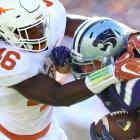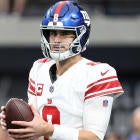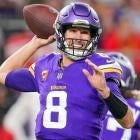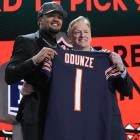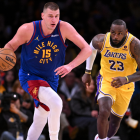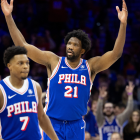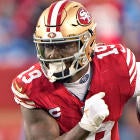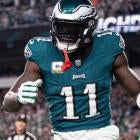The linebacker spot is one of the best groups in the 2018 draft class, and that's not just because of Roquan Smith and Tremaine Edmunds.
There are three or four more high-quality off-ball linebacker prospects who'll likely be picked in one of the first two rounds and will become solid NFL players.
Below I've ranked each of the consensus top off-ball linebackers in the qualities I deem most necessary to be successful at those positions in the pros (listed in order of importance). I've also added one player who should be available a bit later in the draft who excels at each particular trait.
Other installments in this series: Quarterbacks, Running Backs, Wide Receivers, Tight Ends, Offensive Tackles, Interior Offensive Linemen, Edge-Rushers, Defensive Tackles
Sideline-to-sideline speed
- Roquan Smith
- Leighton Vander Esch
- Malik Jefferson
- Tremaine Edmunds
- Darius Leonard
- Rashaan Evans
Smith ran 4.51 at slightly over 6-foot and 236 pounds, and he plays that fast on the field. Many of his impact plays came when he ranged from his spot in the middle of Georgia's defense to the sideline on either an outside run or wide receiver screen. Vander Esch also flies to the football, although he doesn't look as fast because he's a tall, long-strider. Jefferson gets to the perimeter in a hurry, and the same can be said about Edmunds. Leonard doesn't lack in the athleticism department whatsoever, and is more than capable of making plays on the outside. Evans has plus physical gifts too.
Sleeper: Jerome Baker
At 6-foot-1 and 229 pounds, Baker has to be a speedy linebacker to win consistently, and he's exactly that. At Ohio State, he looks like what's become the norm at the collegiate and professional ranks: a large safety playing linebacker.
Coverage skills
- Leonard
- Smith
- Vander Esch
- Edmunds
- Evans
- Jefferson
Leonard is terrific smoothly following running backs out of the backfield and tight ends down the seam. He's a keenly aware, fluid athlete with plus long speed. Changing direction is not a problem for him, which also helps in coverage. Smith demonstrated tight coverage at Georgia often because of supreme athletic talents and route-recognition skills. Vander Esch is good in zone, where his length and speed are best utilized. Edmunds has insane coverage upside, yet his recognition skills are a tick slow when moving backward. Evans and Jefferson are the most effective making plays close to the line of scrimmage yet neither are heavy footed.
Sleeper: Skai Moore
Moore intercepted 14 passes -- at least three each year -- during his productive, four-year career at South Carolina and knocked down six other throws. He's a choppy mover but gets from point A to point B quickly. He's quick to drop into zone down the seam and react to what he's seeing from the quarterback in the pocket.
Tackling reliability
- Smith
- Vander Esch
- Evans
- Edmunds
- Leonard
- Jefferson
Smith is as sure of a tackler as they come, and his film is littered with big hits and, more importantly, textbook wrap-up takedowns. Vander Esch is a reliable tackler on plays near the line of scrimmage, where a large portion of his tackles are made. Evans and Edmunds will miss a tackle occasionally, but not frequently enough for it to be considered an issue. Leonard's tackling skills are good too, and he packs plenty of power when he gets to the ball-carrier. Jefferson flies all over the field, and his immense speed leads to a fair amount of whiffs when he gets in perfect position.
Sleeper: Chris Worley
Mostly a between-the-tackles playmaker who's kind of a throwback linebacker, Worley is super consistent when he gets his hands on an offensive player who's holding the football.
Block-shedding
- Smith
- Leonard
- Evans
- Edmunds
- Vander Esch
- Jefferson
To me, the ability to shed blocks separates the good linebackers from the superstars. Smith has a plan when blockers approach, often initiating contact to keep himself from being driven backward. Even when long-armed offensive linemen get into his frame, he is violent enough with his hand use to shed quickly to get in the running lane. Leonard too is aggressive on his shedding attempts, and it typically pays off. The rest of the players in this group struggle to disengage from blockers, the lone, clear-cut knock on their games.
Sleeper: Jason Cabinda
Like Smith and Evans, Cabinda isn't afraid of contact, and he's not shy about asserting his will on bigger offensive linemen in his assigned gap. At times, his jolt surprises blockers and leads to the Penn State linebacker having an easy route to the ball-carrier.
Pass-Rushing/Blitzing
- Evans
- Edmunds
- Jefferson
- Smith
- Leonard
- Vander Esch
Evans' pass-rushing skill comes mainly on the edge, where he was used by Nick Saban. His suddenness and hand use allow him to create a fair amount of pressure around the corner. Edmunds and Jefferson can overwhelm interior blockers by converting speed to power on A-gap blitzes. Edmunds could see some time on the edge too at 6-4 and nearly 260 pounds. Because Smith is smaller, his impact as a blitzer mostly comes from his agility and aggressive hands to work past offensive linemen. Leonard's high-cut frame doesn't help him as a blitzer. His springy athleticism does. Vander Esch isn't as powerful as you'd expect at 6-4 and 256 when sent on blitzes up the middle.
Sleeper: Micah Kiser
Kiser looks like an old-school linebacker... compact, strong, and effective between the tackles. He thrived as a run-stopper and was used frequently as an inside blitzer. His low center of gravity, deceptive athleticism, and upper body strength allow him to create disruption in the backfield.
Scheme Fits
Middle Linebacker
- Smith
- Vander Esch
- Evans
- Leonard
- Edmunds
- Jefferson
Smith is ready to be the quarterback of a defense and run with tight ends down the seam. Vander Esch's combination of range, coverage experience and size would translate to well to a spot in the middle. Evans is your classic Alabama linebacker with a bit more athleticism than we saw from the likes of Reggie Ragland, who was a second-round pick in 2016 and turned in a quality run-stopping season in 2017. Leonard has the skills to play in the middle but would probably be best utilized more on the outside, and the rawness that Edmunds and Jefferson display getting off blocks would create issues at middle linebacker.
Sleeper: Cabinda
From his non-stop motor, to his block-shedding ability, good speed and deceptive change-of-direction skills, Cabinda seems like a classic middle linebacker with just enough athleticism to stick in today's souped-up, pass-happy NFL. If he sheds a few pounds to get a tick faster, that'd probably help him, but he's a smart second-level defender who was productive in his three years as a starter with the Nittany Lions.
Weakside Linebacker
- Edmunds
- Smith
- Vander Esch
- Jefferson
- Leonard
- Evans
With Edmunds's linear speed and ridiculous length, he's the new-age physical prototype at the weakside spot, which is a position typically played by the most athletic linebacker on the defense, someone who can be a tackling machine if kept "clean" from mobile blockers. Despite their difference in size, both Smith and Vander Esch could be 125-plus tackle linebackers in a weakside role, and although he can play a bit high, making him a bigger target for offensive linemen, Leonard's athletic gifts would bode well as a run-and-chase linebacker. Evans would probably be best inside
Sleeper: Dorian O'Daniel
One of my favorite prospects in the entire class -- my No. 31 overall prospect -- O'Daniel is a fast, agile, reliable tackler who's proficient in zone coverage defender and a productive blitzer. The former Clemson standout is the exact type of player a team should want at weakside linebacker.
Strongside Linebacker
- Evans
- Edmunds
- Vander Esch
- Jefferson
- Leonard
- Smith
Given his flashes of impressive edge-rushing skills and overall physical nature, Evans is the best strongside linebacker prospect of this group -- a position typically shifted closer to the line of scrimmage in under fronts. He's athletic enough to handle some coverage responsibilities too. Edmunds's mammoth frame and explosiveness would make a fine candidate for a "SAM" role in the NFL. The same can be applied to the comparably sized Vander Esch. Jefferson isn't small by any stretch at over 6-foot-2 and 235-plus pounds. Leonard and Smith are middle or weakside 'backers.
Sleeper: Fred Warner
Warner has the size -- over 6-foot-3 and 236 pounds -- and toughness to be a team's primary strongside linebacker. While he was involved with many tackles near the line of scrimmage and has quality range, he's also capable of flipping his hips and getting downfield in coverage. The BYU alum is one of the draft's sleepers likely best at weakside or strongside in the NFL.












